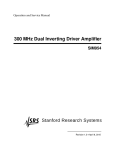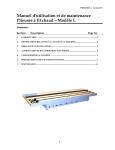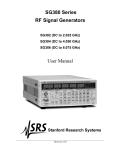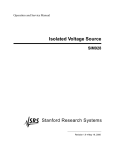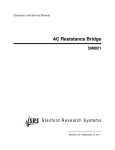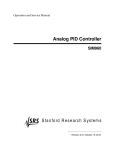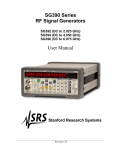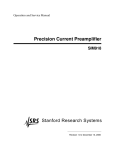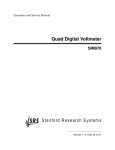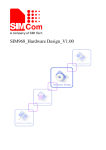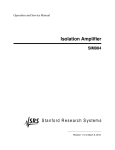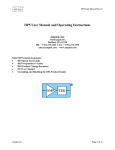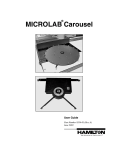Download Manual - Stanford Research Systems
Transcript
Operation and Service Manual Analog Summing Amplifier SIM980 Stanford Research Systems Revision 1.8 • May 18, 2006 Certification Stanford Research Systems certifies that this product met its published specifications at the time of shipment. Warranty This Stanford Research Systems product is warranted against defects in materials and workmanship for a period of one (1) year from the date of shipment. Service For warranty service or repair, this product must be returned to a Stanford Research Systems authorized service facility. Contact Stanford Research Systems or an authorized representative before returning this product for repair. Information in this document is subject to change without notice. c Stanford Research Systems, Inc., 2005, 2006. All rights reserved. Copyright Stanford Research Systems, Inc. 1290–D Reamwood Avenue Sunnyvale, CA 94089 USA Phone: (408) 744-9040 • Fax: (408) 744-9049 www.thinkSRS.com • e-mail: [email protected] Printed in U.S.A. SIM980 Analog Summing Amplifier Contents General Information Symbols . . . . . . . . . . . . . . . . . . . . . . . . . . . . . Notation . . . . . . . . . . . . . . . . . . . . . . . . . . . . . Specifications . . . . . . . . . . . . . . . . . . . . . . . . . . iii iv v vi 1 Getting Started 1.1 Introduction to the Instrument . . . . . . . . . . . . 1.2 Front-Panel Operation . . . . . . . . . . . . . . . . . 1.3 SIM Interface . . . . . . . . . . . . . . . . . . . . . . . 1–1 . 1–2 . 1–2 . 1–4 2 Remote Operation 2.1 Index of Common Commands . 2.2 Alphabetic List of Commands . 2.3 Introduction . . . . . . . . . . . 2.4 Commands . . . . . . . . . . . . 2.5 Status Model . . . . . . . . . . . . . . . . 2–1 . 2–2 . 2–4 . 2–6 . 2–6 . 2 – 17 . . . . . . 3–1 . 3–2 . 3–2 . 3–2 . 3–4 . 3–6 . 3–7 Circuitry 4.1 Circuit Descriptions . . . . . . . . . . . . . . . . . . . 4.2 Parts Lists . . . . . . . . . . . . . . . . . . . . . . . . 4.3 Schematic Diagrams . . . . . . . . . . . . . . . . . . 4–1 . 4–2 . 4–4 . 4–5 3 4 . . . . . Performance Tests 3.1 Introduction . . . . . . . . . . . . 3.2 Tools and preparation . . . . . . 3.3 Precalibration Values . . . . . . . 3.4 Calibration . . . . . . . . . . . . . 3.5 Other tests and adjustments . . . 3.6 SIM980 Performance Test Record . . . . . . . . . . . . . . . . . . . . . . . . . . . . . . . . . . . . . . . . . . . . . . . . . . . . . . . . . . . . . . . . . . . . . . . . . . . . . . . . . . . . . . . . . . . . . . . . . . . . . . . . . . . . . . i ii Contents SIM980 Analog Summing Amplifier General Information The SIM980 Summing Amplifier, part of Stanford Research Sysetems’ Small Instrumentation Modules family, is a four-input, unity-gain amplifier for combining multiple analog signals from DC to 1 MHz. Service Do not install substitute parts or perform any unauthorized modifications to this instrument. The SIM980 is a single-wide module designed to be used inside the SIM900 Mainframe. Do not turn on the power until the module is completely inserted into the mainframe and locked in place. iii iv General Information Symbols you may Find on SRS Products Symbol Description Alternating current Caution - risk of electric shock Frame or chassis terminal Caution - refer to accompanying documents Earth (ground) terminal Battery Fuse On (supply) Off (supply) SIM980 Analog Summing Amplifier General Information v Notation The following notation will be used throughout this manual. WARNING A warning means that injury or death is possible if the instructions are not obeyed. CAUTION A caution means that damage to the instrument or other equipment is possible. Typesetting conventions used in this manual are: • Front-panel buttons are set as [Button]; [Adjust ] is shorthand for “[Adjust ] & [Adjust ]”. • Front-panel indicators are set as Overload. • Remote command names are set as *IDN?. • Literal text other than command names is set as OFF. Remote command examples will all be set in monospaced font. In these examples, data sent by the host computer to the SIM980 are set as straight teletype font, while responses received by the host computer from the SIM980 are set as slanted teletype font. SIM980 Analog Summing Amplifier vi General Information Specifications Performance Characteristics Number of inputs Function Gain Input impedance Bandwidth Output voltage noise Crosstalk Offset voltage Input range Output range Input slew rate Total Harmonic Distortion Output slew rate Operating temperature Power 4 Inverting, non-inverting, or off 1× 1 MΩ DC to 1 MHz √ 30 nV/ Hz@ 1 kHz, max. −80 dB @ 1 kHz ±100 µV (after 5 min. warm up) ±10 V before overload ±10 V before overload 40 V/µs 0.01% (−80 dB) max. @ 1 kHz 75 V/µs 0 ◦ C to 40 ◦ C, non-condensing +5 V (100 mA) ±15 V (300 mA) General Characteristics Interface Connectors Weight Dimensions Serial (RS-232) through SIM interface BNC (5 front, 1 rear) DB–15 (male) SIM interface 1.5 lbs 1.500 W × 3.600 H × 7.000 D SIM980 Analog Summing Amplifier 1 Getting Started This chapter gives you the necessary information to get started quickly with the SIM980 Summing Amplifier. In This Chapter 1.1 1.2 1.3 Introduction to the Instrument 1.1.1 Overview . . . . . . . . 1.1.2 Power-on State . . . . . Front-Panel Operation . . . . . 1.2.1 Inputs . . . . . . . . . . 1.2.2 Output . . . . . . . . . . SIM Interface . . . . . . . . . . 1.3.1 SIM interface connector 1.3.2 Direct interfacing . . . . . . . . . . . . . . . . . . . . . . . . . . . . . . . . . . . . . . . . . . . . . . . . . . . . . . . . . . . . . . . . . . . . . . . . . . . . . . . . . . . . . . . . . . . . . . . . . . . . . . . . . . . . . . . . 1–2 1–2 1–2 1–2 1–3 1–4 1–4 1–4 1–4 1–1 1–2 1.1 Getting Started Introduction to the Instrument The SIM980 Summing Amplifier is a four-input, unity-gain amplifier for combining multiple analog signals from DC to 1 MHz. 1.1.1 Overview The basic function of the SIM980 is to add or subtract up to four analog signals. Each input channel can be separately configured for inverting or non-inverting operation, or switched off. Each input is 1 MΩ and DC-coupled, and accepts signals between ±10 V. 1.1.2 Power-on State The SIM980 stores its operation state (input channel configuration) in non-volatile memory. At power-on, the SIM980 will return to its previous configuration after a brief system check and initialization. 1.2 Front-Panel Operation The front panel of the SIM980 (see Figure 1.1) provides a simple operator interface. Figure 1.1: The SIM980 front and rear panels. SIM980 Analog Summing Amplifier 1.2 Front-Panel Operation 1.2.1 1–3 Inputs Each of the four input channels of the SIM980 has a front-panel block consisting of the BNC input connector, a control button, and several LED indicators. 1.2.1.1 Polarity toggle Each input can be switched between inverting or non-inverting polarity by briefly pressing that channel’s control button. When inverting, the − LED is illuminated; when non-inverting, + is lit. Note that the polarity is always displayed, independent of whether that channel is on or off. 1.2.1.2 On/Off toggle Each input can independently be turned on or off by holding that channel’s control button for ∼1.5 seconds. When on, the channel is either added to or subtracted from the output (depending on polarity, section 1.2.1.1). When off, it does not contribute to the output signal at all. The OFF LED is lit to indicate when a channel is off. Unused channels should be turned off rather than simply left unconnected, as the Johnson noise of the open 1 MΩ input resistor will dominate the output noise of the SIM980. 1.2.1.3 Offset autocalibration The SIM980 uses an active input offset correction to trim all input circuitry as well as the summing circuitry of DC offsets. The user can initiate an autocalibration cycle by disconnecting all inputs and outputs from the SIM980, and pressing and holding any of the control buttons for ∼5 seconds. The entire process takes approximately 1 minute, and is completed when the relays have stopped “clicking” for at least 10 seconds. Note that it is important that all inputs be open (or, preferably, shorted to ground) before initiating an offset autocalibration cycle. If any input channel is above ∼500 µV amplitude, the SIM980 will reject the autocalibration request. 1.2.1.4 Input Overload Each of the four input channels of the SIM980 has an overload detection circuit. The input is considered overloaded when the signal magnitude exceeds ±10 V. This is indicated by the red OVLD LED at the top of each front-panel block. SIM980 Analog Summing Amplifier 1–4 1.2.2 Getting Started Output The resulting sum of the enabled input channels appears at the output BNC connectors on the front and rear panels. Each output connection is through a 50 Ω resistor. For normal operation, the user should not need to terminate the output. If a 50 Ω termination is applied, note that the output signal will be divided in half. If the output signal exceeds ±10 V, the output overload detection is activated. This is indicated by the red OVLD near the top of the “OUTPUT” block on the front panel. 1.3 SIM Interface The primary connection to the SIM980 Summing Amplifier is the rear-panel DB–15 SIM interface connector. Typically, the SIM980 is mated to a SIM900 Mainframe via this connection, either through one of the internal Mainframe slots, or the remote cable interface. It is also possible to operate the SIM980 directly, without using the SIM900 Mainframe. This section provides details on the interface. CAUTION 1.3.1 The SIM980 has no internal protection against reverse polarity, missing supply, or overvoltage on the power supply pins. Misapplication of power may cause circuit damage. SRS recommends using the SIM980 together with the SIM900 Mainframe for most applications. SIM interface connector The DB–15 SIM interface connector carries all the power and communications lines to the instrument. The connector signals are specified in Table 1.1 1.3.2 Direct interfacing The SIM980 is intended for operation in the SIM900 Mainframe, but users may wish to directly interface the module to their own systems without the use of additional hardware. The mating connector needed is a standard DB–15 receptacle, such as Amp part # 747909-2 (or equivalent). Clean, well-regulated supply voltages of ±15,+5 VDC must be provided, following the pin-out specified in Table 1.1. Ground must be provided on pins 1 and 8, with chassis ground on pin 9. The −STATUS signal may be monitored on pin 2 for a low-going TTL-compatible output indicating a status message. SIM980 Analog Summing Amplifier 1.3 SIM Interface Pin 1 2 3 4 5 6 7 8 9 10 11 12 13 14 15 1–5 Direction Src ⇒ Dest Signal SIGNAL GND −STATUS RTS CTS −REF 10MHZ −5 V −15 V PS RTN CHASSIS GND TXD RXD +REF 10MHz +5 V +15 V +24 V MF ⇒ SIM SIM ⇒ MF MF ⇒ SIM SIM ⇒ MF MF ⇒ SIM MF ⇒ SIM MF ⇒ SIM MF ⇒ SIM MF ⇒ SIM SIM ⇒ MF MF ⇒ SIM MF ⇒ SIM MF ⇒ SIM MF ⇒ SIM Description Ground reference for signal Status/service request (GND = asserted, +5 V= idle) HW handshake (+5 V= talk; GND = stop) HW handshake (+5 V= talk; GND = stop) 10 MHz reference (no connection in SIM980) Power supply (no connection in SIM980) Power supply Power supply return Chassis ground Async data (start bit = “0”= +5 V; “1” = GND) Async data (start bit = “0”= +5 V; “1” = GND) 10 MHz reference (no connection in SIM980) Power supply Power supply Power supply (no connection in SIM980) Table 1.1: SIM Interface Connector Pin Assignments, DB-15 1.3.2.1 Direct interface cabling If the user intends to directly wire the SIM980 independent of the SIM900 Mainframe, communication is usually possible by directly connecting the appropriate interface lines from the SIM980 DB–15 plug to the RS-232 serial port of a personal computer.1 Connect RXD from the SIM980 directly to RD on the PC, TXD directly to TD, and similarly RTS→RTS and CTS→CTS. In other words, a null-modem style cable is not needed. To interface directly to the DB–9 male (DTE) RS-232 port typically found on contemporary personal computers, a cable must be made with a female DB–15 socket to mate with the SIM980, and a female DB–9 socket to mate with the PC’s serial port. Separate leads from the DB–15 need to go to the power supply, making what is sometimes know as a “hydra” cable. The pin-connections are given in Table 1.2. 1.3.2.2 Serial settings The initial serial port settings at power-on are: 9600 Baud, 8–bits, no parity, 1 stop bit, and RTS/CTS flow control. The serial baud rate is fixed, but the word size and parity may be changed with the FLOW or PARI commands. 1 SIM980 Although the serial interface lines on the DB-15 do not satisfy the minimum voltage levels of the RS-232 standard, they are typically compatible with desktop personal computers Analog Summing Amplifier 1–6 Getting Started DB–15/F to SIM980 Name DB–9/F 3 ←→ 7 4 ←→ 8 10 ←→ 3 11 ←→ 2 5 7 ←→ 13 ←→ 14 ←→ 8,9 ←→ 1 ←→ RTS CTS TxD RxD Computer Ground to P/S −15 VDC +5 VDC +15 VDC Ground (P/S return current) Signal Ground (separate wire to Ground) Table 1.2: SIM980 Direct Interface Cable Pin Assignments SIM980 Analog Summing Amplifier 2 Remote Operation This chapter describes operating the SIM980 over the serial interface. In This Chapter 2.1 2.2 2.3 2.4 2.5 Index of Common Commands . . . . . . . . . . . . Alphabetic List of Commands . . . . . . . . . . . . Introduction . . . . . . . . . . . . . . . . . . . . . . . 2.3.1 Power-on configuration . . . . . . . . . . . . 2.3.2 Buffers . . . . . . . . . . . . . . . . . . . . . . 2.3.3 Device Clear . . . . . . . . . . . . . . . . . . . Commands . . . . . . . . . . . . . . . . . . . . . . . 2.4.1 Command Syntax . . . . . . . . . . . . . . . . 2.4.2 Notation . . . . . . . . . . . . . . . . . . . . . 2.4.3 Examples . . . . . . . . . . . . . . . . . . . . 2.4.4 Amplifier Commands . . . . . . . . . . . . . 2.4.5 Autocalibration Commands . . . . . . . . . . 2.4.6 Serial Communication Commands . . . . . . 2.4.7 Status Commands . . . . . . . . . . . . . . . 2.4.8 Interface Commands . . . . . . . . . . . . . . Status Model . . . . . . . . . . . . . . . . . . . . . . 2.5.1 Status Byte (SB) . . . . . . . . . . . . . . . . . 2.5.2 Service Request Enable (SRE) . . . . . . . . . 2.5.3 Standard Event Status (ESR) . . . . . . . . . 2.5.4 Standard Event Status Enable (ESE) . . . . . 2.5.5 Communication Error Status (CESR) . . . . . 2.5.6 Communication Error Status Enable (CESE) 2.5.7 Overload Status (OVCR) . . . . . . . . . . . . 2.5.8 Overload Status (OVSR) . . . . . . . . . . . . 2.5.9 Overload Status Enable (OVSE) . . . . . . . . 2–2 2–4 2–6 2–6 2–6 2–6 2–6 2–7 2–8 2–8 2–9 2 – 10 2 – 11 2 – 11 2 – 13 2 – 17 2 – 18 2 – 19 2 – 19 2 – 19 2 – 20 2 – 20 2 – 21 2 – 21 2 – 21 2–1 2–2 2.1 Remote Operation Index of Common Commands symbol i,j z definition Integers Literal token (?) var {var} [var] Required for queries; illegal for set commands parameter always required required parameter for set commands; illegal for queries optional parameter for both set and query forms Amplifier CHAN(?) i {,j} READ? [i] 2 – 9 Channel Control 2 – 9 Read Offset Voltage Autocalibration ARMC(?) [z] ACAL OFST(?) i {,j} 2 – 10 Arm Autocalibration 2 – 10 Perform Offset Autocalibration 2 – 10 Offset Value Serial Communications FLOW(?) {z} 2 – 11 Flow Control PARI(?) {z} 2 – 11 Parity Status *STB? [i] *SRE(?) [i,] {j} *CLS *ESR? [i] *ESE(?) [i,] {j} CESR? [i] CESE(?) [i,]{j} OVCR? [i] OVSR? [i] OVSE(?) [i,]{j} PSTA(?) {z} 2 – 11 2 – 11 2 – 12 2 – 12 2 – 12 2 – 12 2 – 12 2 – 12 2 – 13 2 – 13 2 – 13 Status Byte Service Request Enable Clear Status Standard Event Status Standard Event Status Enable Comm Error Status Comm Error Status Enable Overload Condition Overload Status Overload Status Enable Pulse −STATUS Mode Interface *RST *IDN? *OPC(?) CONS(?) {z} LEXE? LCME? 2 – 13 2 – 14 2 – 14 2 – 14 2 – 14 2 – 15 Reset Identify Operation Complete Console Mode Execution Error Command Error SIM980 Analog Summing Amplifier 2.1 Index of Common Commands LBTN? TOKN(?) {z} TERM(?) {z} SIM980 Analog Summing Amplifier 2–3 2 – 15 Button 2 – 15 Token Mode 2 – 16 Response Termination 2–4 2.2 Remote Operation Alphabetic List of Commands ? *CLS *ESE(?) [i,] {j} *ESR? [i] *IDN? *OPC(?) *RST *SRE(?) [i,] {j} *STB? [i] 2 – 12 2 – 12 2 – 12 2 – 14 2 – 14 2 – 13 2 – 11 2 – 11 Clear Status Standard Event Status Enable Standard Event Status Identify Operation Complete Reset Service Request Enable Status Byte A ACAL ARMC(?) [z] 2 – 10 Perform Offset Autocalibration 2 – 10 Arm Autocalibration C CESE(?) [i,]{j} CESR? [i] CHAN(?) i {,j} CONS(?) {z} 2 – 12 2 – 12 2–9 2 – 14 Comm Error Status Enable Comm Error Status Channel Control Console Mode F FLOW(?) {z} 2 – 11 Flow Control L LBTN? LCME? LEXE? 2 – 15 Button 2 – 15 Command Error 2 – 14 Execution Error O OFST(?) i {,j} OVCR? [i] OVSE(?) [i,]{j} OVSR? [i] 2 – 10 2 – 12 2 – 13 2 – 13 Offset Value Overload Condition Overload Status Enable Overload Status P PARI(?) {z} PSTA(?) {z} 2 – 11 Parity 2 – 13 Pulse −STATUS Mode R READ? [i] 2 – 9 Read Offset Voltage SIM980 Analog Summing Amplifier 2.2 Alphabetic List of Commands 2–5 T TERM(?) {z} TOKN(?) {z} SIM980 Analog Summing Amplifier 2 – 16 Response Termination 2 – 15 Token Mode 2–6 2.3 Remote Operation Introduction Remote operation of the SIM980 is through a simple command language documented in this chapter. Both set and query forms of most commands are supported, allowing the user complete control of the summing amplifier from a remote computer, either through the SIM900 Mainframe or directly via RS-232 (see Section 1.3.2.1). See Table 1.1 for specification of the DB–15 SIM interface connector. 2.3.1 Power-on configuration The settings for the remote interface are 9600 baud with no parity and hardware flow control, and local echo disabled (CONS OFF). Most of the SIM980 instrument settings are stored in non-volatile memory, and at power-on the instrument returns to the state it was last in when power was removed. Exceptions are noted in the command descriptions. Reset values of parameters are shown in boldface. 2.3.2 Buffers Incoming data from the host interface is stored in a 64-byte input buffer. Characters accumulate in the input buffer until a command terminator (either hCRi or hLFi) is received, at which point the message is parsed and executed. Query responses from the SIM980 are buffered in a 64-byte output queue. If the input buffer overflows, then all data in both the input buffer and the output queue are discarded, and an error is recorded in the CESR and ESR status registers. 2.3.3 Device Clear The SIM980 host interface can be asynchronously reset to its poweron configuration by sending an RS-232-style hbreaki signal. From the SIM900 Mainframe, this is accomplished with the SIM900 SRST command; if directly interfacing via RS-232, then use a serial break signal. After receiving the Device Clear, the interface is reset and CONS mode is turned OFF. Note that this only resets the communication interface; the basic function of the SIM980 is left unchanged; to reset the instrument, see *RST. 2.4 Commands This section provides syntax and operational descriptions for reomote commands. SIM980 Analog Summing Amplifier 2.4 2.4.1 Commands 2–7 Command Syntax The four letter mnemonic (shown in CAPS) in each command sequence specifies the command. The rest of the sequence consists of parameters. Commands may take either set or query form, depending on whether the “?” character follows the mnemonic. Set only commands are listed without the “?”, query only commands show the “?” after the mnemonic, and optionally query commands are marked with a “(?)”. Parameters shown in { } and [ ] are not always required. Parameters in { } are required to set a value, and are omitted for queries. Parameters in [ ] are optional in both set and query commands. Parameters listed without any surrounding characters are always required. Do not send ( ) or { } or [ ] as part of the command. Multiple parameters are separated by commas. Multiple commands may be sent on one command line by separating them with semicolons (;) so long as the input buffer does not overflow. Commands are terminated by either hCRi or hLFi characters. Null commands and whitespace are ignored. Execution of command(s) does not begin until the command terminator is received. tokens Token parameters (generically shown as z in the command de- scriptions) can be specified either as a keyword or integer value. Command descriptions list the valid keyword options, with each keyword followed by its corresponding integer value. For example, to set the response termination sequence to hCRi+hLFi, the following two commands are equivalent: TERM CRLF —or— TERM 3 For queries that return token values, the return format (keyword or integer) is specified with the TOKN command. SIM980 Analog Summing Amplifier 2–8 2.4.2 Remote Operation Notation The following table summarizes the notation used in the command descriptions: 2.4.3 symbol i,j z definition Integers Literal token (?) var {var} [var] Required for queries; illegal for set commands parameter always required required parameter for set commands; illegal for queries optional parameter for both set and query forms Examples Each command is provided with a simple example illustrating its usage. In these examples, all data sent by the host computer to the SIM980 are set as straight teletype font, while responses received the host computer from the SIM980 are set as slanted teletype font. The usage examples vary with respect to set/query, optional parameters, and token formats. These examples are not exhaustive, but are intended to provide a convenient starting point for user programming. SIM980 Analog Summing Amplifier 2.4 2.4.4 Commands 2–9 Amplifier Commands CHAN(?) i {,j} Channel Control Set (query) input channel i {to state j=(-1, 0, +1)}. Setting channel i to j=0 will turn that channel off. Setting j=+1 (or any positive value less than 32767) turns that channel on, and sets the polarity to non-inverting. Setting j=-1 (or any negative value greater than −32768) also turns that channel on, but sets the polarity to inverting. All four channels can be set or queried simultaneously by setting i=0. Example: In the following, all four channels are first commanded off, then channels 1 and 2 are turned on the opposite polarities. Finally, the single-channel and four-channel queries are shown. CHAN 0,0 CHAN 1,+1 CHAN 2,-1 CHAN? 2 -1 CHAN? 0 1,-1,0,0 READ? [i] Read Offset Voltage Query the output voltage, in tenths of microvolts. When the offset autocalibration circuitry is active, an internal highgain amplifier is activated to monitor the SIM980 output. This signal is digitized by an internal analog-to-digital converter. The READ? query allows the user to directly record this measurement. When READ? is queried, the high-gain amplifier is turned on. When the query has finished averaging, the high-gain amplifier is turned off again. The optional parameter i is the averaging time, in milliseconds. The valid range is 10 <i< 10000, with a default value of 1000 (1 second). The query result is in integer tenths of microvolts. That is, READ? returns Vout × 107 /V. The total range is (roughly) −1260 <READ?< 27650, corresponding to output voltages in the range −1.26 mV through +27.6 mV. Example: READ? -151 SIM980 Analog Summing Amplifier 2 – 10 2.4.5 Remote Operation Autocalibration Commands The SIM980 has an internal offset trimming circuit (see section 1.2.1.3). The following set of commands provides detailed control over this subsystem. ARMC(?) [z] Arm Autocalibration Test and set (or query) the armed flag for autocalibration. If z=(FORCE 1), the armed flag is set without testing. The offset autocalibration proceedure requires that all inputs to the SIM980 be at 0 V (that is, either open or shorted to ground). The ARMC command performs a test of all 4 channels to ensure that each input is less than ∼ 500 µV amplitude. If all four channels are okay, the armed flag is set; otherwise it is cleared. The entire test takes about 15 seconds to complete. If ARMC FORCE is set, the armed flag will be set without performing any test of the input channels. Example: ARMC; ARMC? 1 ACAL Perform Offset Autocalibration If the armed flag is set (see ARMC, above), an ACAL command will initiate an offset autocalibration cycle. The entire process takes between 30 s and 90 s, and should ideally be performed only after the SIM980 has been allowed to warm up at least 30 minutes. Example: ACAL; *OPC? 1 OFST(?) i {,j} Offset Value Set (query) the low-level offset trim for channel i {to j=(0. . . 255)}. The result of the ACAL command is stored at 6 low-level offset trims. The OFST allows direct access to these values. The input-channelspecific offset for channels 1 through 4 are stored in i=1 through 4, respectively. For these settings, increasing j causes the input offset adjust to decrease by about 6 µV per count. i=5 and 6 both adjust the summing node offset voltage. Increasing j for i=5 causes the output voltage to decrease (by about 4.4 µV per count), while increasing j for i=6 causes the output voltage to increase (with roughly the same sensitivity). All 6 offset values can be simultaneously set to a single value j by OFST 0,j. Note, however, there is no corresponding multi-channel SIM980 Analog Summing Amplifier 2.4 Commands 2 – 11 query. Values stored by OFST or ACAL are stored in non-volatile memory, and are not affected by power-cycling or *RST. Example: OFST? 4 106 2.4.6 Serial Communication Commands FLOW(?) {z} Flow Control Set (query) flow control {to z=(NONE 0, RTS 1, XON 2)}. After power-on, modules default to FLOW RTS flow control. Example: FLOW 0 PARI(?) {z} Parity Set (query) parity {to z = (NONE 0, ODD 1, EVEN 2, MARK 3, SPACE 4)}. After power-on, modules default to PARI NONE. Example: PARI EVEN 2.4.7 Status Commands The Status commands query and configure registers associated with status reporting of the SIM980. *STB? [i] Status Byte Reads the Status Byte register [bit i]. Execution of the *STB? query (without the optinal bit i) always causes the −STATUS signal to be deasserted. Note that *STB? i will not clear −STATUS, even if bit i is the only bit presently causing the −STATUS signal. See also the PSTA command. Example: *STB? 16 *SRE(?) [i,] {j} Service Request Enable Set (query) the Service Request Enable register [bit i] {to j}. Example: *SRE 0,1 SIM980 Analog Summing Amplifier 2 – 12 *CLS Remote Operation Clear Status *CLS immediately clears the ESR, CESR, and OVSR. Example: *CLS *ESR? [i] Standard Event Status Reads the Standard Event Status Register [bit i]. Upon executing *ESR?, the returned bit(s) of the ESR register are cleared. Example: *ESR? 64 *ESE(?) [i,] {j} Standard Event Status Enable Set (query) the Standard Event Status Enable Register [bit i] {to j}. Example: *ESE 6,1 ESE? 64 CESR? [i] Comm Error Status Query Comm Error Status Register [for bit i]. Upon executing a CESR? query, the returned bit(s) of the CESR register are cleared. Example: CESR? 0 CESE(?) [i,]{j} Comm Error Status Enable Set (query) Comm Error Status Enable Register [for bit i] {to j} Example: CESE? 0 OVCR? [i] Overload Condition Query Overload Condition Register [for bit i]. Example: OVCR? 3 SIM980 Analog Summing Amplifier 2.4 Commands OVSR? [i] 2 – 13 Overload Status Query Overload Status Register [for bit i]. Upon executing a OVSR? query, the returned bit(s) of the OVSR register are cleared. Example: OVSR? 0 1 OVSE(?) [i,]{j} Overload Status Enable Set (query) Overload Status Enable Register [bit i] {to j}. Example: OVSE 16 PSTA(?) {z} Pulse −STATUS Mode Set (query) the Pulse −STATUS Mode {to z=(OFF 0, ON 1)}. When PSTA ON is set, any new service request will only pulse the −STATUS signal low (for a minimum of 1 µs). The default behavior is to latch −STATUS low until a *STB? query is received. At power-on, PSTA is set to OFF. Example: PSTA? OFF 2.4.8 Interface Commands Interface commands provide generic control over the interface between the SIM980 and the host computer. *RST Reset Reset the SIM980 to default configuration. After *RST, all channels are set to positive polarity, and to off. This is equivalent to the following command sequence: CHAN 0,1; CHAN 0,0 Example: *RST SIM980 Analog Summing Amplifier 2 – 14 *IDN? Remote Operation Identify Read the device identification string. The identification string is formatted as: Stanford Research Systems,SIM980,s/n******,ver#.# where ****** is the 6-digit serial number, and #.# is the firmware revision level. Example: *IDN? Stanford Research Systems,SIM980,s/n003075,ver1.21 *OPC(?) Operation Complete Operation Complete. Sets the OPC flag in the ESR register. The query form *OPC? writes a 1 in the output queue when complete, but does not affect the ESR register. Example: *OPC CONS(?) {z} Console Mode Set (query) the Console mode {to z=(OFF 0, ON 1)}. CONS causes each character received at the Input Buffer to be copied to the Output Queue. At power-on and Device-Clear, CONS is set to OFF. Example: CONS? 0 LEXE? Execution Error Query the last execution error code. A query of LEXE? always clears the error code, so a subsequent LEXE? will return 0. Valid codes are: Value 0 1 2 3 16 Definition No execution error since last LEXE? Illegal value Wrong token Invalid bit Autocalibration not armed Example: *STB? 12; LEXE?; LEXE? 3 0 The error (3, “Invalid bit,”) is because *STB? only allows bit-specific queries of 0–7. The second read of LEXE? returns 0. SIM980 Analog Summing Amplifier 2.4 Commands LCME? 2 – 15 Command Error Query the last command error code. A query of LCME? always clears the error code, so a subsequent LCME? will return 0. Valid codes are: Value 0 1 2 3 4 5 6 7 8 9 10 11 12 13 14 Definition No execution error since last LCME? Illegal command Undefined command Illegal query Illegal set Missing parameter(s) Extra parameter(s) Null parameter(s) Parameter buffer overflow Bad floating-point Bad integer Bad integer token Bad token value Bad hex block Unknown token Example: *IDN LCME? 4 The error (4, “Illegal set”) is due to the missing “?”. LBTN? Button Query the channel number of the last button pressed. A query of LBTN? always clears the button code, so a subsequent LBTN? will return 0. Example: LBTN? 1 TOKN(?) {z} Token Mode Set (query) the Token Query mode {to z=(OFF 0, ON 1)}. If TOKN ON is set, then queries to the SIM module that return tokens will return the text keyword; otherwise they return the decimal integer value. Thus, the only possible responses to the TOKN? query are ON and 0. On reset, TOKN is set to OFF. Example: TOKN OFF SIM980 Analog Summing Amplifier 2 – 16 TERM(?) {z} Remote Operation Response Termination Set (query) the htermi sequence {to z=(NONE 0, CR 1, LF 2, CRLF 3, LFCR 4)}. The htermi sequence is appended to all query responses sent by the module, and is constructed of ASCII character(s) 13 (carriage return) and 10 (line feed). The token mnemonic gives the sequence of characters. At power-on, TERM is set to CRLF. Example: TERM? 3 SIM980 Analog Summing Amplifier 2.5 2.5 Status Model 2 – 17 Status Model The SIM980 status registers follow the hierarchical IEEE–488.2 format. A block diagram of the status register array is given in Figure 2.1. There are three categories of registers in the SIM980 status model: Condition Registers : These read-only registers correspond to the real-time condition of some underlying physical property being monitored. Queries return the latest value of the property, and have no other effect. Condition register names end with CR. Event Registers : These read-only registers record the occurrence of defined events. When the event occurs, the corresponding bit is set to 1. Upon querying an event register, any set bits within it are cleared. These are sometimes known as “sticky bits,” since once set, a bit can only be cleared by reading its value. Event register names end with SR. Enable Registers : These read/write registers define a bitwise mask for their corresponding event register. If any bit position is set in an event register while the same bit position is also set in the enable register, then the corresponding summary bit message is set. Enable register names end with SE. Communication Error Status Standard Event Status DCAS: Device Clear 7 CTSH: CTS Halted 6 7 RTSH: RTS Halted 5 OVR: Input Buffer Overrun 4 5 HWOVRN: Hardware Overrun 3 NOISE: Noise Error 2 3 FRAME: Framing Error 1 PARITY: Parity Error 0 1 6 4 PON: Power On 7 URQ: User Request 6 7 CME: Command Error 5 EXE: Execution Error 4 5 DDE: Device Error 3 QYE: Query Error 2 3 2 7 7 CESB INP: Input Buffer Error 1 OPC: Operation Complete 0 1 6 X MSS 0 5 5 ESB ESE 4 4 IDLE 3 3 undef ESR 6 4 CESR 2 0 CESE Overload Status undef X undef X X X X X undef X OVLD_OUTPUT 4 X X 4 4 OVLD_CH4 3 OVLD_CH3 2 3 3 2 2 OVLD_CH2 1 OVLD_CH1 0 1 1 0 0 Status Byte 2 2 undef 1 1 undef 0 SB 0 OVSB SRE OVCR OVSR OVSE Figure 2.1: Status Register Model for the SIM980. SIM980 Analog Summing Amplifier -STATUS 2 – 18 2.5.1 Remote Operation Status Byte (SB) The Status Byte is the top-level summary of the SIM980 status model. When masked by the Service Request Enable register, a bit set in the Status Byte causes the −STATUS signal to be asserted on the rearpanel SIM interface connector. Typically, −STATUS remains asserted (low) until a *STB? query is received, at which time −STATUS is deasserted (raised)1 . After clearing the −STATUS signal, it will only be re-asserted in response to a new status-generating condition. Weight Bit 1 2 4 8 16 32 64 128 0 1 2 3 4 5 6 7 Flag OVSB undef (0) undef (0) undef (0) IDLE ESB MSS CESB OVSB : Overload Status Summary Bit. Indicates whether one or more of the enabled flags in the Overload Status Register has become true. IDLE : Indicates that the Input Buffer is empty and the command parser is idle. Can be used to help synchronize SIM980 query responses. ESB : Event Status Bit. Indicates whether one or more of the enabled events in the Standard Event Status Register is true. MSS : Master Summary Status. Indicates whether one or more of the enabled status messages in the Status Byte register is true. Note that while −STATUS is released by the *STB? query, MSS is only cleared when the underlying enabled bit message(s) are cleared. CESB : Communication Error Summary Bit. Indicates whether one or more of the enabled flags in the Communication Error Status Register has become true. Bits in the Status Byte are not cleared by the *STB? query. These bits are only cleared by reading the underlying event registers, or by clearing the corresponding enable registers. 1 but see the PSTA command SIM980 Analog Summing Amplifier 2.5 2.5.2 Status Model 2 – 19 Service Request Enable (SRE) Each bit in the SRE corresponds one-to-one with a bit in the SB register, and acts as a bitwise AND of the SB flags to generate the MSS bit in the SB and the −STATUS signal. Bit 6 of the SRE is undefined—setting it has no effect, and reading it always returns 0. This register is set and queried with the *SRE(?) command. This register is cleared at power-on. 2.5.3 Standard Event Status (ESR) The Standard Event Status register consists of 8 event flags. These event flags are all “sticky bits” that are set by the corresponding event, and cleared only by reading or with the *CLS command. Reading a single bit (with the *ESR? i query) clears only bit i. Weight Bit 1 2 4 8 16 32 64 128 0 1 2 3 4 5 6 7 Flag OPC INP QYE DDE EXE CME URQ PON OPC : Operation Complete. Set by the *OPC command. INP : Input Buffer Error. Indicates data has been discarded from the Input Buffer. QYE : Query Error. Indicates data in the Output Queue has been lost. DDE : Device Dependent Error. This bit is undefined in the SIM980. EXE : Execution Error. Indicates an error in a command that was successfully parsed. Out-of-range parameters are an example. The error code can be queried with LEXE?. CME : Command Error. Indicates a parser-detected error. The error code can be queried with LCME?. URQ : User Request. Indicates a front-panel button was pressed. PON : Power On. Indicates that an off-to-on transition has occurred 2.5.4 Standard Event Status Enable (ESE) The ESE acts as a bitwise AND with the ESR register to produce the single bit ESB message in the Status Byte Register (SB). It can be set and queried with the *ESE(?) command. SIM980 Analog Summing Amplifier 2 – 20 Remote Operation This register is cleared at power-on. 2.5.5 Communication Error Status (CESR) The Communication Error Status register consists of 8 event flags; each of which is set by the corresponding event, and cleared only by reading or with the *CLS command. Reading a single bit (with the CESR? i query) clears only bit i. Weight Bit 1 2 4 8 16 32 64 128 0 1 2 3 4 5 6 7 Flag PARITY FRAME NOISE HWOVRN OVR RTSH CTSH DCAS PARITY : Parity Error. Set by serial parity mismatch on incoming data byte. FRAME : Framing Error. Set when an incoming serial data byte is missing the STOP bit. NOISE : Noise Error. Set when an incoming serial data byte does not present a steady logic level during each asynchronous bitperiod window. HWOVRN : Hardware Overrun. Set when an incoming serial data byte is lost due to internal processor latency. Causes the Input Buffer to be flushed, and resets the command parser. OVR : Input Buffer Overrun. Set when the Input Buffer is overrun by incoming data. Causes the Input Buffer to be flushed, and resets the command parser. RTSH : Undefined for the SIM980. Command Error. Indicates a parserdetected error. CTSH : Undefined for the SIM980. DCAS : Device Clear. Indicates the SIM980 received the Device Clear signal (an RS-232 hbreaki). Clears the Input Buffer and Output Queue, and resets the command parser. 2.5.6 Communication Error Status Enable (CESE) The CESE acts as a bitwise AND with the CESR register to produce the single bit CESB message in the Status Byte Register (SB). It can be set and queried with the CESE(?) command. SIM980 Analog Summing Amplifier 2.5 Status Model 2 – 21 This register is cleared at power-on. 2.5.7 Overload Status (OVCR) The Overload Condition Register consists of 5 single-bit monitors of conditions within the SIM980. Bits in the OVCR reflect the real-time values of their corresponding signals. Reading the entire register, or individual bits within it, does not affect the OVCR. Weight Bit 1 2 4 8 16 32 64 128 0 1 2 3 4 5 6 7 Flag Overload Channel 1 Overload Channel 2 Overload Channel 3 Overload Channel 4 Overload Output undef (0) undef (0) undef (0) Overload Channel n : The input buffer for Channel n is overloaded (input voltage exceeds ±10 V). Note that the overload detection is active even if the channel is off. Overload Output : The output of the summing amplifier is overloaded (output voltage exceeds ±10 V). Note that the output can overload without any input channel overloading, and vice versa. 2.5.8 Overload Status (OVSR) The Overload Status Register consists of (latching) event flags that correspond one-to-one with the bits of the OVCR (see above). Upon the transition 0 → 1 of any bit within the OVCR, the corresponding bit in the OVSR becomes set. Bits in the OVSR are unaffected by the 1 → 0 transitions in the OVCR, and are cleared only by reading or with the *CLS command. Reading a single bit (with the OVSR? i query) clears only bit i. 2.5.9 Overload Status Enable (OVSE) The OVSE acts as a bitwise AND with the OVSR register to produce the single bit OVSB message in the Status Byte Register (SB). It can be set and queried with the OVSE(?) command. This register is cleared at power-on. SIM980 Analog Summing Amplifier 2 – 22 Remote Operation SIM980 Analog Summing Amplifier 3 Performance Tests This chapter describes how to adjust the SIM980 to improve its offset and gain accuracy, and verify performance. In This Chapter 3.1 3.2 3.3 3.4 3.5 3.6 Introduction . . . . . . . . . . . . . Tools and preparation . . . . . . . Precalibration Values . . . . . . . 3.3.1 Offset Voltages . . . . . . . 3.3.2 Calibration Words . . . . . 3.3.3 DC Gain Match . . . . . . . 3.3.4 AC Gain Match . . . . . . . Calibration . . . . . . . . . . . . . 3.4.1 Offset Adjustment . . . . . 3.4.2 DC Gain Calibration . . . . 3.4.3 AC Gain Calibration . . . . Other tests and adjustments . . . SIM980 Performance Test Record . . . . . . . . . . . . . . . . . . . . . . . . . . . . . . . . . . . . . . . . . . . . . . . . . . . . . . . . . . . . . . . . . . . . . . . . . . . . . . . . . . . . . . . . . . . . . . . . . . . . . . . . . . . . . . . . . . . . . . . . . . . . . . . . . . 3–2 3–2 3–2 3–2 3–3 3–3 3–3 3–4 3–4 3–5 3–5 3–6 3–7 3–1 3–2 3.1 Performance Tests Introduction Under typical usage, only the internal autocalibration cycle is needed to keep the SIM980 operating within specifications (see section 1.2.1.3). If further adjustment is needed, this section describes the procedure. 3.2 Tools and preparation The necessary tools for a complete recalibration are: • a small flat-head screwdriver • a voltmeter with microvolt resolution and stability (SIM970 or equivalent) • a quiet DC voltage source (SIM928 or equivalent) • a 1 MHz (minimum) sine generator (DS345 or equivalent) • a 20 MHz bandwidth (minimum) oscilloscope • several BNC patch cables • 4 BNC-Tee adapters, or 3 Tees and 1 F/F barrel. For the full offset calibration procedure the module should be running for at least 15 minute. The trimpots are accessible after removing the right side panel. It is easier to calibrate the module by connecting it through a cable to the SIM extension port, but the calibration can also be performed with the module located in the left-most slot (slot 1) of a SIM900 Mainframe with slots 2–5 empty. 3.3 Precalibration Values If precalibration values are not required, skip ahead to section 3.4. Precalibration values should be recorded on a separate copy of the performance test record (page 3 – 7 ). 3.3.1 Offset Voltages Begin by disconnecting all inputs from the SIM980, and connecting the output to the voltmeter. Switch all channels to OFF, and record the output voltage as “Offset Voltage: Output”. Enable Channel 1, set the polarity to +, and record the output voltage. Change the polarity to −, and subtract this output voltage from the previous value. Record the difference as “Offset Voltage:Channel 1”. Disable Channel 1, and repeat for the remaining 3 channels. SIM980 Analog Summing Amplifier 3.3 3.3.2 Precalibration Values 3–3 Calibration Words Next, query the SIM980 over the remote interface to determine the calibration word values. Send the remote queries: OFST? 1 ... OFST? 6 and record the results. 3.3.3 DC Gain Match Set the DC voltage source to 2 V. Connect the BNC-Tee adapters together to form a 1-to-4 splitter. Connect the splitter to the DC voltage source, and connect the four SIM980 inputs to the splitter with equal-length cables (important for AC testing, later). Enable all four input channels, and set all input polarities to +. Note the output voltage as V1+ . Then change all four input polarities to −, and note the output voltage as V1− . Now switch the DC voltage source to −2 V, and with the channel polarities still set to − note the output voltage as V2− . Change all four input polarities to +, and finally note the output voltage as V2+ . Calculate the gain ratio mismatch as ! V1+ − V2+ − 1 × 100 % V1− − V2− and record this value as the “DC mismatch”. 3.3.4 AC Gain Match Using the same 1-to-4 splitter from section 3.3.3, connect all four input channels to the sine generator, set to create a 1 MHz sine wave at 1 Vrms or 1 Vpeak-peak amplitude (circle which). Unlike the DC case, here it is important that all four BNC cables leading to the channel inputs are of exactly the same length and type and that the splitting of the signal is accomplished in a symmetric manner. Differences in cable length will introduce phase shifts between inputs and falsify the result. Connect the output of the SIM980 to the oscilloscope. Separately trigger the scope synchronously with the sine generator. AC matching is measured pairwise between channels, with the two channels under test set to opposite polarity and the remaining two channels switched off. There are 12 such permutations, which can be labeled with a +− notation. For example, setting Channel 1 SIM980 Analog Summing Amplifier 3–4 Performance Tests non-inverting, Channel 3 inverting, and Channels 2 & 4 off is noted as “+−”. Measure the amplitude for each permutation, and record the results (circle either RMS or peak-to-peak) 3.4 Calibration Prior to beginning calibration, photocopy a blank version of the performance test record (page 3 – 7 ). 3.4.1 Offset Adjustment Calibration starts by disconnecting all inputs and resetting the electronic output offset calibration constants. This is accomplished by issuing the remote commands: CHAN 0,0 OFST 5, 128; OFST 6, 127 which set the electronic trim-DAC outputs to midpoint. Connect the SIM980 output to the voltmeter, and adjust R245 to zero the voltage reading. After nulling R245, an unconditional autocalibration cycle should be initiated. Issue the following remote commands: ARMC FORCE; ACAL to arm and start internal calibration. The autocalibration will complete in approximately one minute (wait for relays to cease switching for at least 10 seconds). The output voltage will fluctuate during calibration but settle to less than ±20 µV. Verify that the calibration words are within the valid range 1–254 by repeating the queries of section 3.3.2. Nominally, all calibration words should be within the range 50–200; values of 0 or 255 indicate that the offsets have shifted outside of the adjustable range and the SIM980 may be damaged. Input offset voltages should be measured directly by the procedure of section 3.3.1. Except for short term drift, the calibration should reduce input offset voltage errors to less than 10 µV. If the result is unsatisfactory, adjustment of the calibration constant may be attempted by manually issuing explicit OFST commands (see section 2.4.5). Manually adjusted constants should differ only slightly (±1 count) from the automatic result. Otherwise the module should be powercycled and the adjustment procedure should be repeated. Record the final offset values, and final calibration words, on the performance test record. SIM980 Analog Summing Amplifier 3.4 3.4.2 Calibration 3–5 DC Gain Calibration All resistors of the SIM980 gain network have a precision of 0.1%. Any two channels can therefore differ in their gain by up to 0.2%. Gain between + and − polarity settings can also differ by 0.2%. The common mode rejection of two channels set to take the difference of two signals is therefore limited to 0.2% or approximately −54 dB worst case. The module has one trimpot to equalize the average positive gain (over all channels) with the average negative gain and give the best overall match for any combination of channels. To find the optimum setting, repeat the setup of section 3.3.3. Set the DC voltage source to approximately 2 V output, and set all four input channels to − polarity. Note the DC output voltage with at least millivolt precision (the value should be ∼ −8.00 V. Now switch all four channels to +, and adjust trimpot R268 to bring the output voltage to the same magnitude, but opposite polarity, as previously noted. Be aware that this procedure depends on neglecting the input offset voltages, so be sure to perform section 3.4.1 first. After completing the calibration, measure the DC gain match according to section 3.3.3, and record the results. 3.4.3 AC Gain Calibration The SIM980 amplifier bandwidth rolls off around 6 MHz. This is accomplished with a combination of fixed capacitors and one trimcap. The trimcap can be adjusted to equalize high-frequency gain below approximately 1 MHz, maximizing the average common mode rejection between channels. Just as in case of the DC gain, the module achieves matching on the order of −60 dB. Above 1 MHz, high order effects begin to dominate and AC gains will vary from channel to channel by more than −50 dB. However, even the worst case channels typically achieve −40 dB (1% gain difference) suppression for any frequency below their −3 dB bandwidth as long as all amplifiers operate in small signal mode (i.e., the slew rate limit is not exceeded). For sinusoidal signals, this translates into 10 V amplitude at 500 kHz and 1 V at 5 MHz. Care must be taken with non-sinusoidal signals which have high slew rate. For this adjustment a 1 MHz sine wave generator and an AC voltmeter or oscilloscope are necessary. Connect the instruments as previously in section 3.3.4. Again, it is crucial that all BNC cables are of exactly the same length and type and that the splitting of the signal is accomplished in a symmetric manner. Differences in cable length will introduce phase SIM980 Analog Summing Amplifier 3–6 Performance Tests shifts between inputs and falsify the result. If in doubt, as a check of symmetric cabling, the measurments may be repeated with the inputs being connected to all possible permutations of the four cables. Inputs are pairwise set to − and + such that the overall AC signal is nulled. There are twelve possible gain combinations for two channel nulling: +− and −+, +− and −+, +− and −+, +− and −+, +− and −+, +− and −+. The combination with the worst common mode rejection is optimized with trimcap C217 and all other combinations are re-checked. After a few iterations a solution with well distributed error can be found. The residual worst case AC voltage will typically be approximately 5 mVrms for a 1 Vrms input. After completing the adjustments, record the results. Some users might want to improve DC and AC matching for a single combination of channels (e.g. channels 1 & 2) while sacrificing the matching for the others. This can be accomplished best by driving the two channels with the same signal and operating one in positive and the other one in negative mode while using R268 and C217 to minimize the difference signal at the output. Please note that reversing the polarity of these two channels will not result in an equally well matched result. The procedure works within a narrower-thanspecified temperature range, and long term drift might make frequent re-calibration necessary. 3.5 Other tests and adjustments The SIM980 internally generates two precision power supply voltages for the input buffer amplifiers. These +13.0 V and −13.0 V voltages can be tested at test points TP401 (+13.0 V), TP402 (−13.0 V) and TP403 (ground). R405 and R402 can be used to adjust the −13.0 V and +13.0 V voltage. There should be no need to ever actually perform this factory adjustment. If either voltage shows a large (> 100 mV) deviation from its ideal value, the module might have been damaged and should be sent to the factory for repair. SIM980 Analog Summing Amplifier 3.6 3.6 SIM980 Performance Test Record 3–7 SIM980 Performance Test Record This page should be photocopied to record results. General Offset Voltage Calibration Words Gain Name: Serial Number: µV µV µV µV µV Output: Channel 1: Channel 2: Channel 3: Channel 4: OFST? OFST? OFST? OFST? OFST? OFST? 1 2 3 4 5 6 DC mismatch: AC mismatch: (@ 1 MHz, 1 V rms / peak-peak) SIM980 Date/Time: Analog Summing Amplifier % +−: −+: +−: −+: +−: −+: +−: −+: +−: −+: +−: −+: mV (rms / peak-peak) mV mV mV mV mV mV mV mV mV mV mV 3–8 Performance Tests SIM980 Analog Summing Amplifier 4 Parts Lists and Schematics This chapter presents a brief description of the SIM980 circuit design. A complete parts list and circuit schematics are included. In This Chapter 4.1 4.2 4.3 Circuit Descriptions . . . . . . . . . . 4.1.1 Input circuitry . . . . . . . . . . 4.1.2 Summing circuitry . . . . . . . 4.1.3 Output circuitry . . . . . . . . . 4.1.4 Offset measurement & control 4.1.5 Digital control . . . . . . . . . . Parts Lists . . . . . . . . . . . . . . . . Schematic Diagrams . . . . . . . . . . . . . . . . . . . . . . . . . . . . . . . . . . . . . . . . . . . . . . . . . . . . . . . . . . . . . . . . . . . . . . . . . . 4–2 4–2 4–2 4–2 4–3 4–3 4–4 4–5 4–1 4–2 4.1 4.1.1 Circuitry Circuit Descriptions Input circuitry Each channel of the SIM980 Summing Amplifier contains a JFET unity gain input buffer amplifer (U201–U204) with input protection (D201–D204). These input buffers have 0.1 µV/◦ C offset voltage drift and are being automatically trimmed to zero offset voltage by means of an eight channel digital analog converter U403. Input buffer amplifiers are powered by LDO voltage regulators U401 and U402 which are set to +13.0 V and −13.0 V, respectively. Discriminators U205–U208 provide under/overvoltage detection for each channel and U209 monitors the output voltage. The OVLDALL signal is generated by or-ing overload signals into a single channel. This signal restarts the module’s microcontroller clock which is inactive in normal operation to minimize noise. The clock is also automatically activated by a button push or a serial command. 4.1.2 Summing circuitry The buffered input signals are summed into precision (0.1%) resistor networks R200A–E and R201A–E which form a difference amplifier with gain 1 around the fast precision amplifier U210. The signal path is controlled by relays K201–K208. A combination of two dual-pole, dual-throw relays per channel allows enable/disable and polarity change with constant noise gain and signal bandwidth. The difference amplifier U210 is buffered by the power buffer U211. This compound amplifier can drive 10 V signals into open and 5 V into two 50 Ω loads. The outputs on the front and back panel can be used simultaneously with resistive isolation between them. The independent 50 Ω series resistors at these outputs also guarantee unlimited stability for any possible passive load and overcurrent/thermal protection for shorted outputs. The combination of U210/U211 is rolled off at a bandwith of 4 MHz by the combintion of C220 and C202. Trim capacitor C217 is factory adjusted for best common mode suppression at high frequencies. 4.1.3 Output circuitry Outputs as well as inputs are equipped with common mode filters (baluns) to reduce conducted EMI (electromagnetic interference) of RF noise currents on the shield of BNC cables attached to the module. For the same reason the BNCs are isolated from the SIM980’s front and back panels. This design ensures the best DC and low frequency performance in noisy environments. Care must be taken not to load the ground connections with currents > 1 A which could destroy the SIM980 Analog Summing Amplifier 4.1 Circuit Descriptions 4–3 differential pair wiring inside the module and disconnect the ground from the isolated BNC jacks. Such a fault could result in harmful voltages being present on the BNC shell. The opamp/buffer combination U210/U211 does not by itself satisfy the offset voltage specifications of the SIM980. Offset voltage stability is therefore guaranteed by U212, a differential integrator which drives a differential current source, QN201A/B, to trim the input offset voltage of U210. The resulting amplifier combines the AC performance of U210 with the stability of the slow amplifier U212. Offset adjustment is performed by two outputs of digital-analog converter U403. 4.1.4 Offset measurement & control Chopper stabilized amplifier U404 is set at a gain of 1000 to measure output offset voltages with the 10-bit, built in analog-digitalconverter of microcontroller U101. In auto-calibration mode the microcontroller can resolve microvolt output voltages and set channels 1–6 of digital-analog-converter U403 to minimize any input and the output offset voltage. Chopper amplifier U404 is switched off during normal operation to eliminate the potential noise generated by its internal chopping circuit. 4.1.5 Digital control The SIM980 is controlled by microcontroller U101. A critical aspect of the design is the clock-stop circuitry implemented by U103 and U105. A simple RC-oscillator is enabled or disabled at pin 1 of U105, which is driven by synchronizing flip-flop U103B to ensure that no “runt” clock pulses are produced that would violate U101’s minimum clock periods. Four separate clock-starting signals are combined by U106: • Power-on reset • Amplifier overload (any) • Incoming serial data • Front-panel button press The fast start-time of the RC-oscillator ensures that incoming serial data will be correctly decoded by the microcontroller’s UART, even when the clock is started by the serial start bit of the incoming data. When the microcontroller has completed all pending activity, it drives the STOP signal high (pin 71 of U101), effectively halting its own processor clock. In this way, the SIM980 guarantees no digital clock artifacts can be generated during quiescent operation. SIM980 Analog Summing Amplifier 4–4 4.2 Circuitry Parts Lists Part Reference C101,C102,C103 C104 C105 C106,C107,C108,C405 C201,C203 C202 C204-C215 C217 C218 C220 C222-C223 C401-C404,X101-106, X108-X114,X201-X224 D101,D102,D402 D103,D104,D205-D207 D201-D204 D301-D308 D309-D313 D314-D317 D401 J101 J103 J201-J206 JS201 JS301 K201-K208 L101,L102,L103 L201-L206 Q101-Q116 Q201-Q206 QN201 R101,R118-119,R122, R123,R213-216,R240, R242-243,R260 R102,R201,R203,R205, R207,R221,R224,R227, R230,R291,R423 R103 R104,R217-R220,R241, R261 R105,R295,R296,R298, R299,R2101 R106,R262,R263 R107-R110,R115 R112,R113, R421,R422 R114,R120,R121, R409-R414,R424 SRS P/N 5-00098 5-00381 5-00106 5-00387 5-00319 5-00368 5-00318 5-00104 5-00363 5-00313 5-00454 5-00299 Value 10µ T 330p 9.0--50p 1000p 10U/T35 27P 2.2U/T35 3.5-20P 10P 1P .01U .1U 3-00945 3-00649 3-00896 3-00424 3-00425 3-00426 3-01384 1-00367 1-00302 1-00003 1-01079 1-01080 3-01492 6-00174 6-00640 3-01421 3-00580 3-01419 4-01527 BAT54S BAW56LT1 BAV99 GREEN RED YELLOW MMBZ5232BLT1 15 Pin D Socket 0.100" 3x2 BNC 20 pin 20 Pin ASX2204H FR43 Bead ToroidChoke MMBT2222A MMBT3906LT1 MBT3906DW1 100k 4-01479 1.0k 4-01052 4-01495 210 4.7k 4-01511 22k 4-01431 4-01519 4-01551 4-01503 10 47K 1.0M 10K Part Reference R116,R124,R125 R117,R126,R127,R223, R226,R229,R232,R238, R284-R287,R292 R128,R246,R265,R288 R202,R204,R206,R208 R209,R211 R210,R212 R222,R225,R228,R231, R267 R233,R239 R234-R237 R245 R249,R252,R255-R259 R250,R251,R253,R254 R266 R268 R289,R290 R401 R402,R405 R403 R404 R406 R407 R408 R415-R420 R425-R428 R431 RN200,RN201 RN301,RN302 S301-S304 U101 U102 U103 U104 U105 U106 U107-U108 U201-U204 U205-U209 U210 U211 U212 U401 U402 U403 U404 U405 SIM980 SRS P/N Value 4-01465 270 4-01455 100 4-01406 4-01405 4-01259 4-01309 4-01535 0 1.00M 30.1K 100K 220K 4-01419 4-01675 4-00617 4-01487 4-01486 4-01541 4-00901 4-01561 4-01402 4-00014 4-01308 4-01310 4-01348 4-01526 4-01517 4-01524 4-01499 4-00925 4-01649 4-00442 2-00053 3-01379 3-00903 3-00742 3-00662 3-01405 3-00663 3-00746 3-01246 3-00728 3-01278 3-01247 3-00998 3-01415 3-01248 3-01279 3-01280 3-01367 3.3 100, 5%, 1/2W 100K 2.2K 2.0K 390k 500K 2.7M 931K 5K 97.6K 102K 255K 91K 39K 75K 6.8K 10 1.000K 1.2K 1206 mini B3F-1052 68HC912B32 MAX6348 4.4V 74HC74 74HC14 74AC00 74HC08 74HC245 AD8610AR LM393 AD829AR BUF634F OPA277UA LP2951CMM LT1175CN8 MAX5258 LTC2050CS5 DG419DY Analog Summing Amplifier 4.3 4.3 Schematic Diagrams 4–5 Schematic Diagrams Schematic diagrams follow this page. SIM980 Analog Summing Amplifier

















































